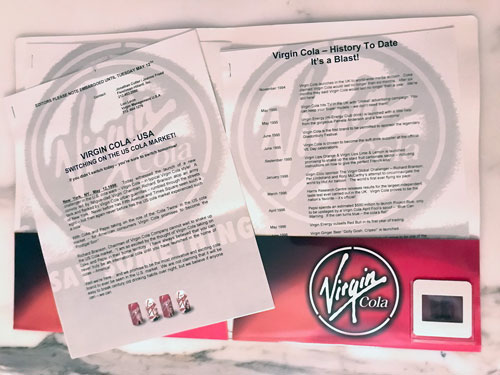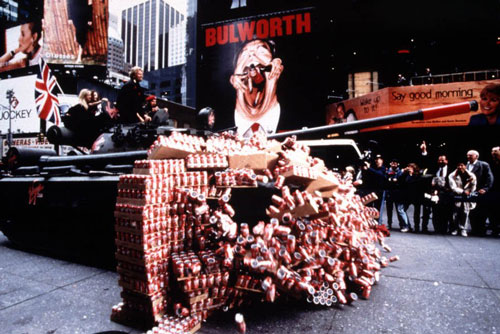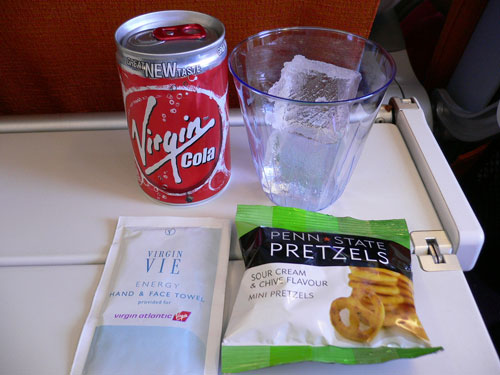Crashing The Soda Wars
The story of Virgin Cola, Richard Branson’s bold attempt to take on Coca-Cola and Pepsi at their own game. Of course it failed, but it did so stylishly.
When’s the last time a newsletter literally got you a free lunch? Today’s sponsor, the Digital Experience Summit, is ready to hook you up. More details below. ↴
1979
The year that Virgin introduced its famous “napkin” logo, which was directly inspired by the label’s signing of the Sex Pistols. The simple look came to life after its well-known founder, Richard Branson, realized the company’s original logo, designed for the prog era, made no sense for the Sex Pistols, a band it had signed in 1977. The logo, the story goes, was made by a graphic designer who sketched on a napkin during a meeting at Branson’s houseboat.

The Virgin Cola press kit in question. (photo by me)
How Richard Branson tried to make private-label soda into something exciting
In a lot of ways, the Virgin Cola story doesn’t really start with Virgin, but with the Canadian beverage manufacturer Cott, now known as the Primo Water Corporation.
You don’t know the company, most likely, but you know its beverages. Most famously, Cott was the company that came up with the Sam’s Choice private-label brand for Walmart, which the retailer first used with sodas but later expanded far beyond them. And outside of the U.S., it’s currently known as the manufacturer of RC Cola, the greatest also-ran of the soda world.
As a firm focused on private-label products (at least until its merger with Primo last year), Cott was a company that lived vicariously through other brands. And Virgin Group had a pretty good one that it was pushing really heavily at the time.
From its record-label and record store roots, Virgin was quickly becoming an empire, one that had gained a global reputation thanks to the founding of Virgin Atlantic Airlines in 1984, and by the ’90s, that napkin logo was slowly getting used on things as diverse as intercity trains, video games, and radio stations. Soon, that brand would be used for mobile phones, health care providers, and … uh, spaceships.
In fact, when the announcement that Virgin Cola was coming, a spokesman for Branson delightfully suggested that Virgin-branded marijuana was on the table. In 1994.
“If it were ever legalized and it were proved to the satisfaction of the BMA (British Medical Association) that it was harmless, he’d obviously consider it,” the spokesman told Reuters at the time.
But soda was different. People don’t buy Sam’s Club cola because they prefer it. They buy it because it’s the cheapest option. Like light beer, the driving factor behind purchase, in most cases, is marketing—lots of it. Despite the fact that cola isn’t all that hard to make and (despite what Coca-Cola has you believe) generally tastes very similar, you don’t see a lot of direct competitors with Coke or Pepsi for a reason.
Branson, whose video game arm had made a game based on a soda brand in 1993, saw the opportunity of going up against some of the largest brands in the world less as a threat and more of a challenge.
In the 2011 edition of his book Losing My Virginity: How I Survived, Had Fun, and Made a Fortune Doing Business My Way, he explained that realized that launching a line of sodas would actually be less risky than it sounded, even if it sounded like something that would prove a really terrible idea from the outside.
“As usual, when people warn me against doing something once my mind is made up, I grow increasingly determined to try it,” he wrote. “In this case we all recognized that it would be an inch-by-inch fight along the shelves of the supermarkets but, once we established that there was minimal financial risk if we failed, we decided to proceed.”
That gave him just the reason he needed to go forward with the idea of a soda brand. Working with Cott, a brand known both for stunt beverages and for efficiently selling the cut-rate brands, Branson could actually get his products into stores at a cheaper price than Coke at the time.
And while Virgin didn’t necessarily have the years of brand loyalty or marketing reach of its established competitors, it had something that the soda giants didn’t: Edge.
At the time that Virgin entered the market, Coke was smarting from a recent attempt to release OK Soda, a brand that tried for a subversive postmodern branding approach rather than one that tried to grab its audience in a way that regular campaigns do. It failed, and pretty spectacularly. The world wasn’t ready for non-advertising-advertising from Coca-Cola.
Virgin was very much known for a degree of subversion, but it was also a brand that wasn’t afraid to actually try to sell you something. So if it could pull off the marketing stunts it was known for, there was a lot of potential upside.
And, of course, limited downside.
Sponsored By DX Summit
Hungry? — Lunch on us during the Digital Experience Summit Next Week
As a Tedium subscriber, you're invited to the most influential technology, marketing and analytics event of the summer!
Register for free today and receive a complimentary voucher for LUNCH ON US while you master new skills and network with the world's most successful digital experience leaders.
Join us on July 29 at 8am PT/11am ET for our great lineup of speakers—including leaders from Harvard Business School, Microsoft, Intellum, Verizon, Appnovation and Stitchfix—as we discuss how to retain customers through data and journey orchestration.
Register today for this digital CX conference to receive a free Uber Eats voucher to use toward lunch delivery of your choice.

Richard Branson driving a tank through Times Square. (via the Virgin website)
Five kinds of marketing stunts Virgin tried when selling Virgin Cola
- Blind taste tests that favored Virgin Cola. Taste tests are not uncommon gimmicks when it comes to cola, and Virgin invested in a lot of taste tests as it tried to get into the market. One third-party one, done by The Observer in 1994, ranked the drink above Coke, and gave the drink credit for being “not too sweet.”
- A top-heavy bottle modeled after Pamela Anderson. During a dinner with his wife and Pamela Anderson, the three discussed the idea of producing a plastic soda bottle that was curved at the top, nicknamed the “Pammy.” The next day, Anderson gave Branson the right to use her name for the idea for free, which created lots of press, both good and bad.
- Richard Branson driving through 3 tons of Coke products in Times Square, using a tank. The gimmick, as part of Virgin Cola’s brand introduction to the U.S., is still considered Virgin’s wildest stunt ever. (He also shot at a giant Coke sign.) “It was before 9/11 so you could get away with things that would be unwise to try today,” Branson told Inc. of the unusual stunt.
- A U.S. ad campaign to get the gay marriage conversation going. One 1998 U.S. ad featured two men getting married on a beach, an ad destined to get people talking, as it was also the first ad to feature a same-sex kiss. The same campaign, reports Ad Age, was said to have featured Joey Buttafucco saying, “I’m famous because some girl decided to shoot my wife in the head.” (That ad, probably for the best, appears not to have run.)
- A UK ad campaign that sold Virgin Cola’s headquarters as the “home of hedonism.” Just a few years before Tank Girl creator Jamie Hewlitt’s distinctive visual style went mainstream as a part of the band Gorillaz, he designed characters for a series of ads for Virgin Cola that hinted at much the same level of cheekiness Virgin’s own brand did.
“At present the soft drinks industry in the U.S. is worth $50 billion (with cola accounting for just under half this figure), if we secure a 1 percent share of this huge soft drinks market we have already sold 100 million cases of Virgin Cola—now that can’t be bad.”
— A sample line from the Virgin Cola press kit I got a hold of. (Yes, the comma after the parenthesis, although not grammatically correct, is how it showed up in 1998.) The kit, which notes that “we are in the U.S. cola market for the long term,” also emphasizes that Coke and Pepsi’s advertising is so similar “that they could be Twins,” giving Virgin an opportunity to drive through the market with its much edgier brand. (For those curious: The press kit does not include a CD-ROM even though it would have been era-appropriate, but does include a slide of what Virgin Cola looks like. The press kit includes a news release, printed on paper, with an embargo of May 12, 1998, discussing the tank stunt listed above.)

Virgin Cola, as shown on a Virgin Atlantic flight. (Satomi Abe/Flickr)
So why aren’t we drinking Virgin Cola?
As proven by his stunts, Richard Branson knew how to drive a tank. Unfortunately for Virgin Cola, Coke knew how to control an army.
According to Branson’s book Losing My Virginity, Coke apparently took the threat of Virgin Cola quite seriously, taking aggressive steps to quash what it saw as a potential long-term threat to its business:
Initially Coca-Cola head office didn’t take Virgin Cola seriously as a threat so we had no opposition from them. What I didn’t know was that based in Atlanta, in Coke’s head office, was an English lady working in a senior position for Coca-Cola. She warned the management there that Virgin had the power and the brand to rock Coke on a worldwide basis and she persuaded her directors to let her set up a SWAT team in England to try and stamp us out. Within days she and her team had moved to England. Retailers were offered unbeatable terms from Coke to take their cola over ours. Smaller retailers were threatened with removal of Coca-Cola fridges. The campaign from Coca-Cola was even more potent than the dirty tricks campaign from British Airways to stamp out Virgin Atlantic but Virgin Cola survived. Ironically this very same lady now holds a senior position at Virgin’s main clearing bank.
A less optimistic view of the firm’s business prospects comes from the U.K. marketing magazine Campaign, which notes that the Virgin Cola brand’s reach wasn’t what it could be in the UK, though it was careful never to imply sabotage, rather simply suggesting that Virgin’s brand was a “little more than an irritant” with a distribution reach of around 30 percent.
There were things to be proud of, though.
“Each cola maker is able to produce favorable, if widely varying market research sales figures, but Virgin’s latest suggest its rivals should be nervous,” the magazine’s Sharon Marshall wrote in 1997. “Although its national share is only around [3 percent to 5 percent], Virgin claims that where its cola is sold in direct competition with Pepsi, it outsells the boys in blue.”
And at the time, setback for the brand was not unheard of. One of Virgin’s earliest wins was when the British discount retailer Iceland took on Virgin Cola shipments at a cut-rate price. By May of 1997, though, the shipments were seen generally as eyesores and Iceland decided it no longer would distribute the beverage.
The uphill battle also became a story for Virgin Cola in the U.S. market, which Coke and Pepsi had even tighter control over. A 1998 Washington Times article noted that Virgin Cola had successfully convinced Target to carry the line, along with at least one major gas-station retailer, but it was by no means the scale it would need to get anywhere near its level of success in other parts of the world.
“Whether or not they even make a tiny, infinitesimal dent in the market is still too early to tell,” Beverage Digest editor John Sicher told the newspaper. “They’ve got a good product and they’ve made a splash with their marketing. But you have to remember they’re competing in the home market and against the flagship brands of two of the best marketing companies in the world. Their challenge is Herculean.”
Despite the challenges, Virgin put on a strong face, as highlighted by the press release I currently have sitting on my coffee table, pledging it will someday be worth a lot of money.
“I am so excited by the thought of Virgin Cola taking on Coke and Pepsi in their home territory,” Branson told CNN Money in 1998. “I have always believed that you can never truly be an international cola until you have launched in the home of the colas—America.”
Certainly, a man whose company owns an airline, a chain of record stores, and a line of cinemas is able to do quite a bit of vertical integration all by himself. But the problem is that the soda industry is everywhere.
Perhaps it was inevitable Virgin would get crushed.
Richard Branson has evolved, gracefully, into an elder statesman of the business world. The marketing is perhaps a little less stunt-driven than it once was (OK, minus the whole flying-into-the-edge-of-space thing), instead replaced by Branson using his considerable business knowledge to highlight what he’s learned over the years.
He still brings up Virgin Cola frequently—mostly as a cautionary tale. Speaking to NPR’s How I Built This podcast back in 2017, he noted that he’s learned to be thoughtful about instances of failure. He explained that the real problem was that Virgin Cola had little in the way of advantage, maybe a slight difference in taste, but the brand was going up against other companies with brands that were just as good, if not better.
“So since then what I learned from that was only to go into businesses where we were palpably better than all the competition,” he said.
Branson has founded hundreds of businesses over the years through Virgin. He can’t shed tears for all of them—he’s not built that way. But unlike the drink itself, Virgin Cola the idea seems to have had a lasting effect.
(Of course, the real question: Can I sell this press kit for an obscene amount of money?)
--
Find this one an interesting read? Share it with a pal!
And thanks again to the Digital Experience Summit for sponsoring—be sure to check out the event! I heard lunch was included.
:format(jpeg)/2017/11/tedium110217.gif)
/2017/11/tedium110217.gif)


/uploads/ernie_crop.jpg)